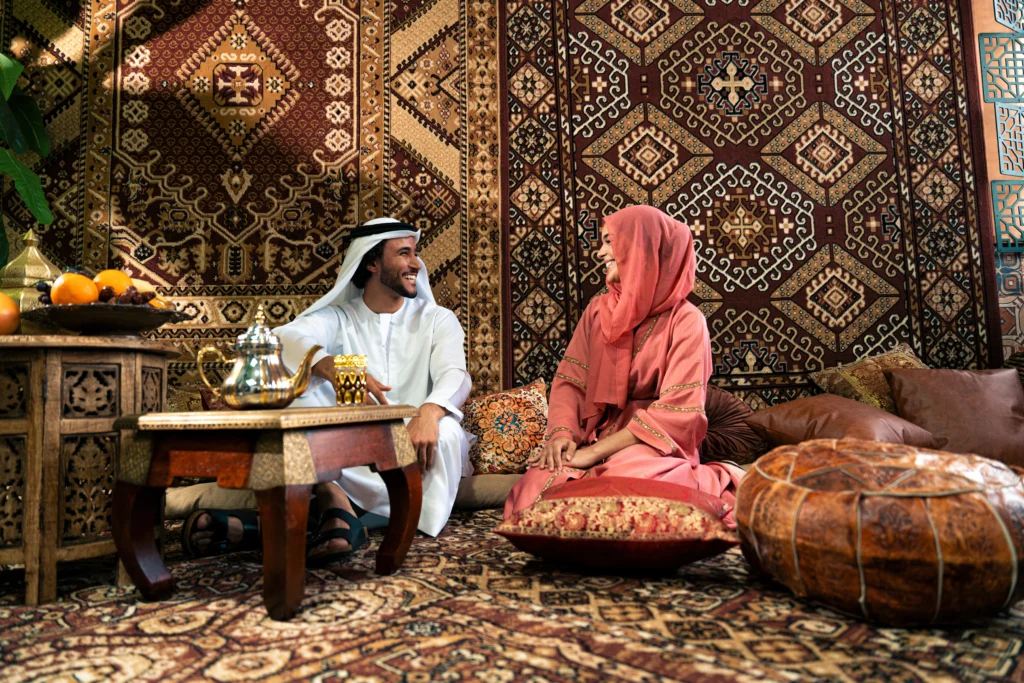The United Arab Emirates (UAE) is a land of stunning contrasts, where ancient traditions seamlessly blend with modern innovations. With its seven emirates, each boasting unique cultural identities, the UAE has worked tirelessly to preserve its rich heritage amidst rapid development. From the deeply-rooted Bedouin traditions to modern celebrations of art and culture, the UAE’s cultural landscape is a fascinating mix that reflects its historical and contemporary narrative.
A Heritage Shaped by the Desert
The Bedouin culture is central to understanding the UAE’s cultural traditions. Historically, the UAE’s ancestors were desert nomads, living off the land and sea in a challenging environment. These Bedouin traditions still influence Emirati society today, with values of hospitality, loyalty, and a deep connection to the desert environment remaining strong.
The Majlis: A Symbol of Hospitality
Hospitality is at the heart of Emirati culture, and nowhere is it more evident than in the Majlis, a traditional gathering space where friends, family, and visitors meet to discuss matters, exchange stories, and enjoy traditional Arabic coffee (gahwa) and dates. The Majlis is a space of both formal and informal gatherings, symbolizing the importance of community and connection in Emirati culture.
Traditional Clothing: A Reflection of Identity
Emirati clothing is not only a reflection of the country’s cultural identity but also of its climatic conditions. The traditional attire of men, known as the kandura or dishdasha, is a long, white robe designed to keep the wearer cool in the hot desert climate. Women wear the abaya, a black cloak, over their clothing, often accompanied by a shayla, a headscarf.
Traditional Emirati clothing is still widely worn today, particularly on special occasions, national holidays, and religious events, symbolizing a strong connection to heritage despite the UAE’s modern development.
Festivals and Celebrations: Honoring Heritage and Unity
The UAE is known for its vibrant festivals that bring together the old and the new. Some of these festivals are deeply rooted in tradition, while others have been adapted to the modern context, yet they all serve as a reminder of the nation’s rich cultural fabric.
Ramadan and Eid: The Spiritual Heart of UAE Culture
Ramadan, the Islamic holy month of fasting, holds a special place in the UAE’s cultural calendar. It is a time for spiritual reflection, family gatherings, and charitable activities. Following Ramadan, the festival of Eid al-Fitr is celebrated with much joy and festivity. Families gather to share meals, give gifts, and offer charity to the less fortunate.
Another important festival is Eid al-Adha, which commemorates the willingness of Prophet Ibrahim to sacrifice his son as an act of obedience to God. Like Eid al-Fitr, this holiday brings families together and promotes acts of charity.
National Day: A Celebration of Unity
UAE National Day, celebrated on December 2, marks the unification of the seven emirates in 1971. The day is celebrated with much fervor and pride, with colorful parades, fireworks, traditional music, and dance performances held across the country. It is a day that celebrates both the country’s achievements and its rich cultural heritage, fostering a sense of national unity and pride among citizens and residents alike.
Traditional Arts and Crafts: Preserving Ancient Skills
The UAE has a long tradition of arts and crafts, passed down through generations. These skills are still valued today and are being preserved as part of the country’s cultural heritage.
Weaving and Textiles
Weaving, particularly the making of Sadu (a traditional form of weaving using camel or goat wool), is an ancient Bedouin craft. The Sadu technique is used to create colorful, geometric patterns on fabrics that are often used for tents, cushions, and clothing. This craft is recognized by UNESCO as an Intangible Cultural Heritage of Humanity, highlighting its significance to Emirati heritage.
Pottery and Metalwork
Pottery and metalwork are also ancient traditions in the UAE, with archaeological evidence suggesting that these crafts have been practiced for thousands of years. Emirati artisans continue to create beautifully crafted pottery and metal goods, often incorporating traditional designs with modern functionality. These crafts can be found in markets across the UAE, and they serve as a tangible link to the country’s past.
Falconry: A Revered Cultural Tradition
Falconry is a sport and tradition that has been practiced in the UAE for centuries. Once a means of hunting for food in the desert, it has now become a revered sport and symbol of heritage in the UAE. The connection between the falconer and the bird is deeply respected, and the UAE has established falconry schools to ensure the tradition continues for future generations.
In fact, falconry is so deeply embedded in Emirati culture that it has been recognized by UNESCO as an Intangible Cultural Heritage of Humanity. Falconry festivals and competitions are held throughout the year, drawing enthusiasts from around the world.
Traditional Music and Dance: A Cultural Expression
Music and dance are essential elements of Emirati culture, often performed during celebrations, festivals, and special occasions. One of the most famous traditional dances is the Al-Ayyala, which involves rows of men waving sticks in unison to the beat of drums. This dance symbolizes the unity and strength of the community and is performed during weddings, national events, and other celebrations.
Traditional Emirati music is often played using instruments like the oud (a type of lute), rebab (a single-stringed instrument), and tabl (a drum). These instruments create the distinctive sound of Emirati music, which is deeply rooted in the country’s Bedouin heritage.
Modern Influences on Emirati Culture
While the UAE has embraced modernity with open arms, it has done so without losing sight of its cultural roots. Cities like Dubai and Abu Dhabi are global hubs for art, design, and innovation, yet they continue to celebrate their traditional culture through festivals, museums, and cultural centers. The Sheikh Zayed Grand Mosque in Abu Dhabi is a perfect example of this blend, combining traditional Islamic architecture with modern design elements.
Cultural initiatives, such as the Louvre Abu Dhabi and the Dubai Opera, have brought international attention to the UAE’s commitment to becoming a global cultural destination. These modern venues provide a platform for both Emirati and international artists, further enriching the country’s cultural landscape.
Conclusion: A Culture of Pride and Progress
The UAE’s cultural traditions are a testament to the resilience and adaptability of its people. While the country continues to evolve into a modern global powerhouse, it remains deeply connected to its heritage. From the ancient Bedouin traditions to the dynamic fusion of modern art and culture, the UAE offers a rich tapestry of experiences that honor both its past and its future.
As the UAE moves forward, it does so with a deep sense of pride in its cultural traditions, ensuring that future generations will continue to celebrate and preserve this unique heritage.

